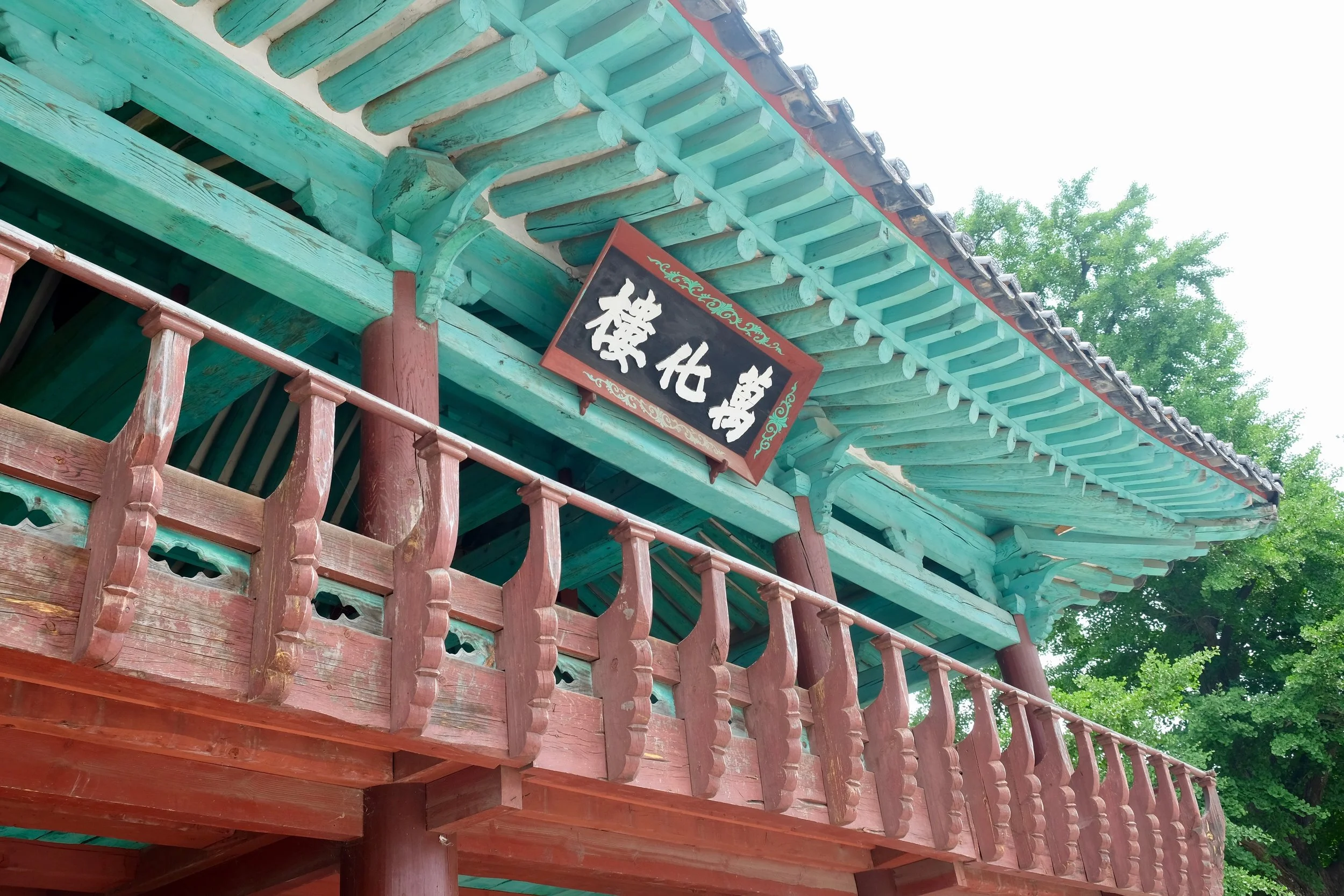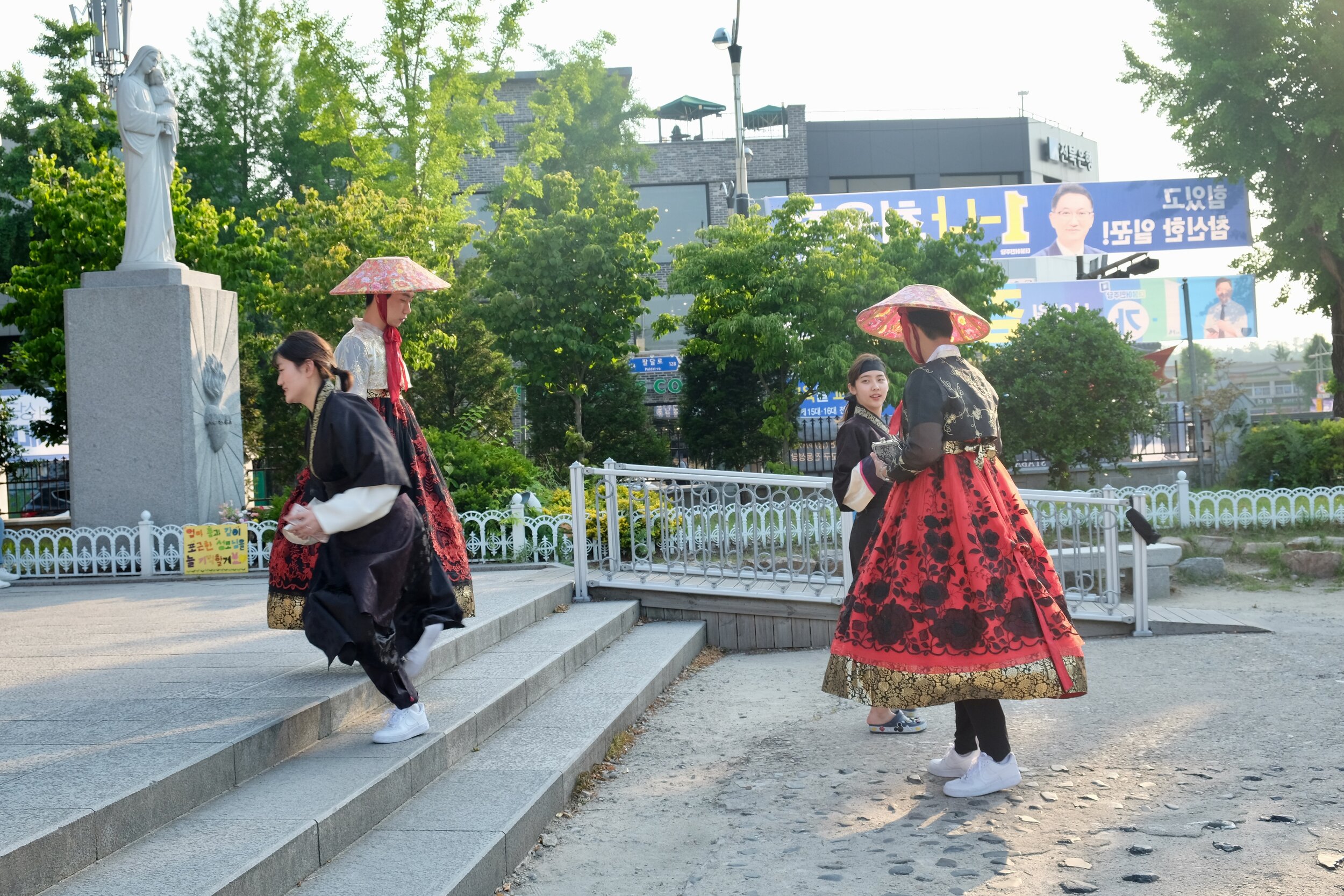The small city of Jeonju holds considerable appeal, and while it’s finally receiving domestic visitors in droves, it’s still largely off the beaten trail of international tourists. Which is a bloody shame, because it’s probably the best place in the country in which to get a proper handle on Korean customs.
The name Jeonju literally means "Perfect (jeon) Region (ju)" in Hanja, and it’s famous for its historic buildings, sports activities, and innovative festivals. First and foremost, it is home to a splendid hanok village (which is where we were planning to stay the next two nights), a cluster of traditional houses which includes a cathedral, an ancient shrine, and a former Confucian academy, as well as museums for calligraphy, paper, and wine.
However, it’s food that most Koreans most readily associate with Jeonju. The city is widely regarded as the place to find the very finest examples of Korean cuisine. Many of the differences are too subtle to be noticed by foreigners, but you’re likely to find a greater and more lovingly prepared number of banchan here, as well as more subtle and complex herbal seasoning than the tried and tested soy sauce, garlic, and red-pepper paste. Particularly notable is the city’s take on the tasty Korean staple, bibimbap.
In May 2012, Jeonju was chosen as a Creative City for Gastronomy as part of UNESCO's Creative Cities Network. This honour recognises the city's traditional home cooking handed down over thousands of years, its active public and private food research, a system of nurturing talented chefs, and its hosting of distinctive food festivals.
This place also has some serious pedigree - Jeonju marked the beginning of one of the longest lines of kings that the world has seen. It was here in the fourteenth century that the first kings of the Joseon kingdom were born, and the dynasty went on to rule Korea for over five centuries.
Needless to say, we were chomping at the bit to get stuck into everything this culinary Mecca could throw at us, and it was around 3 PM when we arrived at our double room at the Heungbuga Hanok. It was off the main road, on a quiet side street, but still close enough to the action. Run by a very cheerful man who was delighted that Jess could understand a bit of Korean, he eagerly showed us to our room and kept marvelling at the fact that we had cycled all the way here.
Heungbuga Hanok, 26-34 Taejo-ro, Wansan-gu, Pungnam-dong, Jeonju-si, South Korea. You can book online here but will pay the proprietor in cash in person.
Lovely bit of signwriting, don’t you think?
At 48,000 won per night, we got a 16m2 room with an ensuite bathroom, mini fridge, TV, and traditional bedding which would be laid out on the floor each night. Don’t expect large amounts of space or too much comfort, as this is modelled on the Korean way of life from the 14th century, but the experience is unique, nonetheless. All rooms come with ondol, a sub-ground heating system that stems from Koreans enjoying sitting, eating, and sleeping on the floor.
While she was unfurling the blankets, Jess recalled a memory of her mother making the beds for the family whenever they visited her grandmother’s house in Seoul. How funny that nearly 25 years later, Jess was doing the same while Neil devastated the bog.
As is the standard layout of a hanok, there was a quiet, enclosed courtyard with a picnic table where we would receive breakfast each morning (included in the price) and have a quiet read before embarking on the day’s activities.
It was just perfect.
Wandering the streets later on, we felt like we had stepped back in time. The village is preserved so as to feature the local architecture, and some 735 buildings exist for your viewing pleasure. And we’re not kidding - there is not a single corner of this place that isn’t photogenic, with beauty lurking everywhere you look.
It also appears to be a place where young people come to relive the days of yore, with the majority of them renting hanboks to float around town with their friends, or pose for couple shots with their significant others. Interestingly, given how Koreans tend to be socially conservative and dislike anything that doesn’t follow gender norms, it didn’t seem like such rules applied when it came to men dressing up in traditional Korean dresses. Perhaps the novelty factor outweighed any potential awkwardness, not that it should matter anyway. Everyone’s just here to have a good time.
As is usually our way, we first steered clear of the sights that everyone else was gravitating towards and instead went exploring around the back streets. Here Neil had one of the most unexpectedly surreal experiences of the entire trip. For no discernible reason, a Korean fast food stall was blasting London comedian Big Shaq’s novelty song, “Man’s Not Hot”. It’s a small world we live in all right.
After a quick snackette of banh mi and chicken skewers from a row of food trucks (we wanted to save ourselves for the main meal of the day), we headed out of the village and walked around Jeonju proper. This being Sunday, very little was open, but we did eye a couple of restaurants that had some decent dinner deals going on for later.
The village was designated as an International Slow City in 2010 in recognition of its relaxed pace of life where traditional culture and nature blend harmoniously.
An interesting concept we came across in a 7-Eleven. The leftmost bottle reads, “Our philosophy is to help our consumers understand that the real value lies in the quality of the product and not in the brand name.” Spot on.
Just outside the village, across the main road that marks its western boundary, lies Pungnammun, an ornate city gate whose present structure dates from 1768, but was originally built in the late fourteenth century as part of Jeonju’s city wall. Now surrounded by a circle of rather drab modern buildings, it holds a gruesome secret - this is where the heads of martyred Christians were displayed after purges in 1801.
On the southern side of the village sits Jeondong Cathedral, looking almost European, with its brown brick walls and soaring spire. It is a temple of Roman-Byzantine style, and was built between 1908 and 1914 by Victor Louis Poisnel. It was one of the first cathedrals to be built in Korea, and remains an active place of worship.
Earlier in the day, we had found one eating establishment that had a special for 35,000 won: a mix of banchan and two beers for two people. Licking our lips with anticipation, we retraced our steps back to the restaurant, pushed the doors, and walked in.
To say that we had no idea what we were getting ourselves into would be a huge understatement. One after another, the dishes just came coming until our entire table (which was big enough for 4 people) was completely covered and then some - Jess had to partake in her favourite activity, making piles, to create space. We truly outdid ourselves and ate about 97% of it all, and worried for a moment that we wouldn’t be able to get up from our chairs due to the bloat.
Round 1 of 3.
We didn’t catch the name of the restaurant in the end, but this is just one of many that offer similar settings. Find one that fits within your price point and don’t think twice about it.
Again, there weren’t that many bars about, but after dinner, we spotted a coffee shop that sold beer on tap and fried chicken, among other things. So we hung out there and watched the world go by - a world that was largely made up of Koreans, for there wasn’t a single foreigner around except us. On the one hand, that made us happy because although Jeonju is certainly a somewhat sanitised and tourist-oriented city, it hasn’t yet been diluted and homogenised to appeal to outsiders. On the other hand, it’s a shame that it’s still so unheralded outside its native land.
Korea is overlooked by much of the Western world, who still prefer to go to China, Japan, and Southeast Asia. After a couple of weeks here, we really feel like it deserves much more consideration. It’s a bit like wanting your favourite band to be successful, but also wanting to keep them to yourself lest the masses ruin everything.
Oh well, their loss is our gain. We can’t wait to see what tomorrow has in store.























